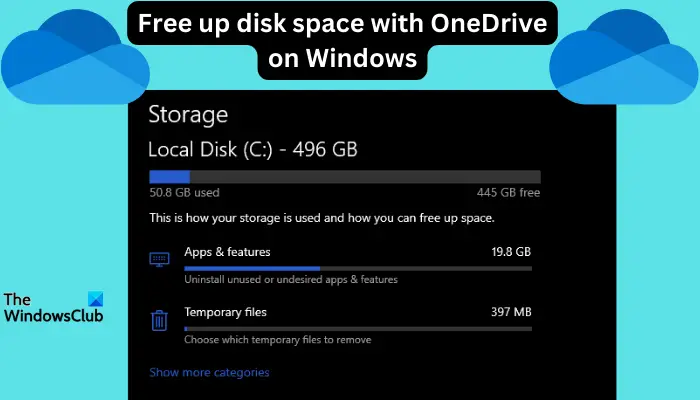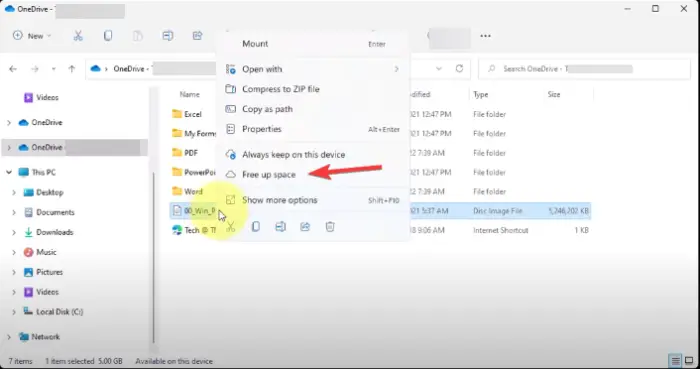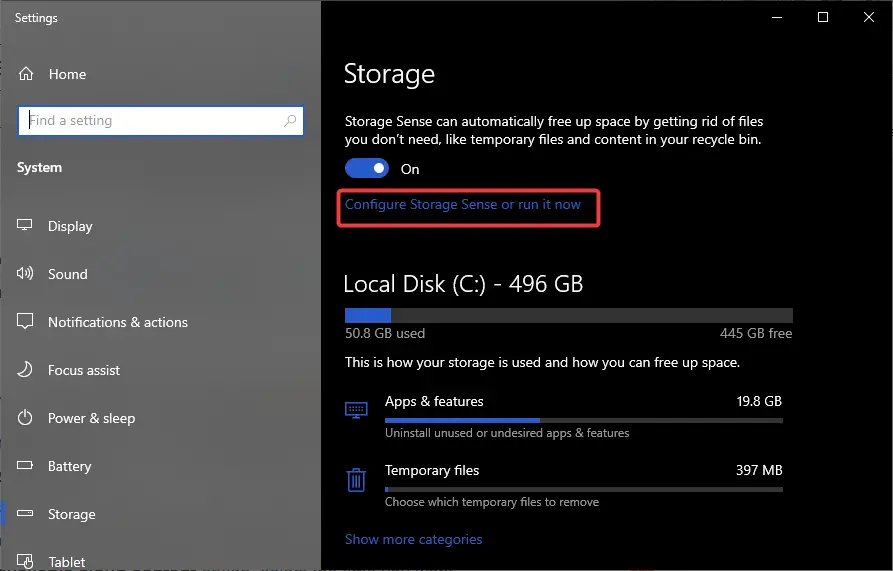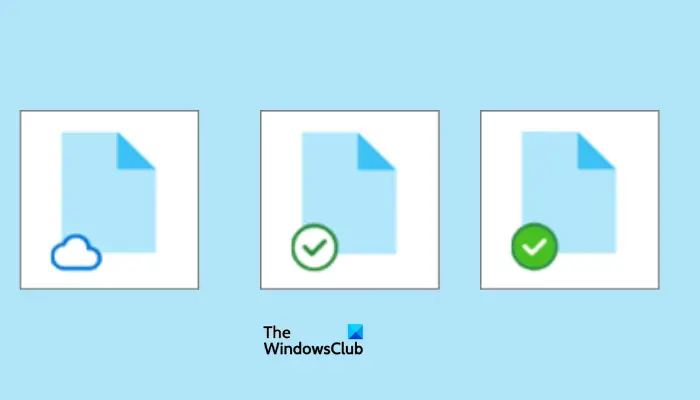How to free up disk space using OneDrive on Windows 11
When you turn on this computer, you find that the disk storage space is full and you need to clean up the local disk to make more space. You can consider deleting some unnecessary files or freeing up disk space on Windows 11 by using OneDrive to help you solve this problem.

In order to successfully use this method, you must enable OneDrive Files On-Demand. We'll teach you how to convert your files to this mode. As long as your OneDrive cloud storage has more space, you can free up more space on your local disk.
Has OneDrive freed up space?
OneDrive utilizes storage awareness to automatically free up local drive space without deleting files. It allows Windows to delete temporary files and Recycle Bin files that are no longer needed.
If Storage Sense is activated and configured, OneDrive will convert files you have not opened within a specified time into "Files on Demand", which can save local disk space. As long as you are connected to the Internet, you can access these files on your local computer at any time without worrying about storage space.
How to free up disk space using OneDrive on Windows 11
To free up disk space in Windows 11, you can make files in your OneDrive folder an on-demand file or selectively free up some files.
To free up space for all OneDrive files, do the following:
Open OneDrive settings by clicking the OneDrive icon in the Windows taskbar area. After that, select the OneDrive Help and Settings icon and finally click on Settings.
Find and click Sync & Backup, then expand Advanced Settings. Here, select Free Disk Space to convert the files to online-only so that they will not be available offline on your local disk.
To free up space for a single file using OneDrive, do the following:

You can free up disk space for each file. Just open the OneDrive folder, right-click on the file, and select Free Space.
Use Storage Sense to automatically release OneDrive space
You can turn on and configure Storage Sense to automatically free up disk space using OneDrive. To do this, follow these steps:
- Search for storage settings in the search box and click Open.
- Under Storage Options, you will see Storage Sense on the right. Turn on this button.
Once the feature is turned on, all your files will be converted to online-only files if they have not been opened or used on OneDrive for 30 days and there is insufficient disk space.

However, you can configure Storage Sense to run periodically. Do the following:
- Return to Storage Settings and under Storage Detection, select Configure Storage Detection or Run Now.
- Select how often you want Storage Sense to run from the drop-down menu.
- You can choose weekly, daily or monthly.
- Under the Locally available cloud content option, select how long you want Storage Sense to convert offline files in your OneDrive folder to online-only files.
Read: How to clear disk space through Windows settings
How to identify files to free up space using OneDrive?
To determine which files can use OneDrive to free up space, pay attention to the status label next to each file in OneDrive. Generally speaking, there are three states, as follows:
- Blue cloud icon. These files have an online-only status. They do not consume any local disk space on your computer and you need an internet connection to access them.
- Green check mark. A green check mark indicates that the file is available online only and is available locally. This means it consumes local disk storage space. If you need more disk space, right-click the file and select Free Space.
- White ticks. This status indicates that the file is available locally on your device and you can access it even without an Internet connection. You can free up space for such files.
The image below shows three status labels that will help you determine which file to free up space with OneDrive on your Windows 11 PC.

What should I do when OneDrive is full?
If your OneDrive is full, the only way to create more space is to delete some files or buy more storage space from Microsoft. You can also download some files and store them in external storage before deleting them later. Check the Recycle Bin for files you want to delete and see what other files are taking up space. Another option is to purchase a paid plan from Microsoft.
We hope you find something valuable here.
The above is the detailed content of How to free up disk space using OneDrive on Windows 11. For more information, please follow other related articles on the PHP Chinese website!

Hot AI Tools

Undresser.AI Undress
AI-powered app for creating realistic nude photos

AI Clothes Remover
Online AI tool for removing clothes from photos.

Undress AI Tool
Undress images for free

Clothoff.io
AI clothes remover

Video Face Swap
Swap faces in any video effortlessly with our completely free AI face swap tool!

Hot Article

Hot Tools

Notepad++7.3.1
Easy-to-use and free code editor

SublimeText3 Chinese version
Chinese version, very easy to use

Zend Studio 13.0.1
Powerful PHP integrated development environment

Dreamweaver CS6
Visual web development tools

SublimeText3 Mac version
God-level code editing software (SublimeText3)

Hot Topics
 Can I install mysql on Windows 7
Apr 08, 2025 pm 03:21 PM
Can I install mysql on Windows 7
Apr 08, 2025 pm 03:21 PM
Yes, MySQL can be installed on Windows 7, and although Microsoft has stopped supporting Windows 7, MySQL is still compatible with it. However, the following points should be noted during the installation process: Download the MySQL installer for Windows. Select the appropriate version of MySQL (community or enterprise). Select the appropriate installation directory and character set during the installation process. Set the root user password and keep it properly. Connect to the database for testing. Note the compatibility and security issues on Windows 7, and it is recommended to upgrade to a supported operating system.
 How to solve mysql cannot connect to local host
Apr 08, 2025 pm 02:24 PM
How to solve mysql cannot connect to local host
Apr 08, 2025 pm 02:24 PM
The MySQL connection may be due to the following reasons: MySQL service is not started, the firewall intercepts the connection, the port number is incorrect, the user name or password is incorrect, the listening address in my.cnf is improperly configured, etc. The troubleshooting steps include: 1. Check whether the MySQL service is running; 2. Adjust the firewall settings to allow MySQL to listen to port 3306; 3. Confirm that the port number is consistent with the actual port number; 4. Check whether the user name and password are correct; 5. Make sure the bind-address settings in my.cnf are correct.
 MySQL can't be installed after downloading
Apr 08, 2025 am 11:24 AM
MySQL can't be installed after downloading
Apr 08, 2025 am 11:24 AM
The main reasons for MySQL installation failure are: 1. Permission issues, you need to run as an administrator or use the sudo command; 2. Dependencies are missing, and you need to install relevant development packages; 3. Port conflicts, you need to close the program that occupies port 3306 or modify the configuration file; 4. The installation package is corrupt, you need to download and verify the integrity; 5. The environment variable is incorrectly configured, and the environment variables must be correctly configured according to the operating system. Solve these problems and carefully check each step to successfully install MySQL.
 Solutions to the errors reported by MySQL on a specific system version
Apr 08, 2025 am 11:54 AM
Solutions to the errors reported by MySQL on a specific system version
Apr 08, 2025 am 11:54 AM
The solution to MySQL installation error is: 1. Carefully check the system environment to ensure that the MySQL dependency library requirements are met. Different operating systems and version requirements are different; 2. Carefully read the error message and take corresponding measures according to prompts (such as missing library files or insufficient permissions), such as installing dependencies or using sudo commands; 3. If necessary, try to install the source code and carefully check the compilation log, but this requires a certain amount of Linux knowledge and experience. The key to ultimately solving the problem is to carefully check the system environment and error information, and refer to the official documents.
 Unable to access mysql from terminal
Apr 08, 2025 pm 04:57 PM
Unable to access mysql from terminal
Apr 08, 2025 pm 04:57 PM
Unable to access MySQL from the terminal may be due to: MySQL service not running; connection command error; insufficient permissions; firewall blocks connection; MySQL configuration file error.
 How to copy and paste mysql
Apr 08, 2025 pm 07:18 PM
How to copy and paste mysql
Apr 08, 2025 pm 07:18 PM
Copy and paste in MySQL includes the following steps: select the data, copy with Ctrl C (Windows) or Cmd C (Mac); right-click at the target location, select Paste or use Ctrl V (Windows) or Cmd V (Mac); the copied data is inserted into the target location, or replace existing data (depending on whether the data already exists at the target location).
 Can mysql run on Windows
Apr 08, 2025 pm 01:54 PM
Can mysql run on Windows
Apr 08, 2025 pm 01:54 PM
Running MySQL on Windows is feasible, but challenges such as port conflicts, permission issues, and environment variable settings need to be considered. Installation issues can be solved by customizing configuration files, adjusting user permissions, and setting environment variables correctly. Additionally, the appropriate storage engine should be selected, tweaked configuration files, and SSDs should be used to optimize performance.
 Can vs code run in Windows 8
Apr 15, 2025 pm 07:24 PM
Can vs code run in Windows 8
Apr 15, 2025 pm 07:24 PM
VS Code can run on Windows 8, but the experience may not be great. First make sure the system has been updated to the latest patch, then download the VS Code installation package that matches the system architecture and install it as prompted. After installation, be aware that some extensions may be incompatible with Windows 8 and need to look for alternative extensions or use newer Windows systems in a virtual machine. Install the necessary extensions to check whether they work properly. Although VS Code is feasible on Windows 8, it is recommended to upgrade to a newer Windows system for a better development experience and security.






